
MANIP maintenance trip April 24
Wartungsreise zum Höhepunkt der Vegetationsperiode in der Dehesa
An internationally renowned research station that continuously measures CO2 fluxes, meteorological variables, vegetation indices, soil respiration, sap flow, changes in the weight of lysimeters and much more. The station is operated in collaboration with the Fundación CEAM, the Spanish National Research Council (CSIC), the University of Extremadura and the Max Planck Institute for Biogeochemistry. Many other teams and scientists have carried out various types of work here. More details at:
https://www.bgc-jena.mpg.de/majadas
MaNiP - Majadas Nitrogen Phoshor
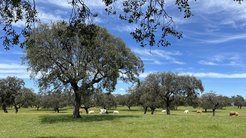
MANIP maintenance trip April 24Our semi-annual maintenance trips to Spain for the MANIP project take us to Extremadura. The vegetation there is characterized by loosely standing holm and cork oaks, these groves on which mostly cattle and sheep graze are also called dehesa.
The experiment covers 3 areas near the village of Majadas del Tietar, about 20 minutes from Plasencia, where there are 3 towers (north, main and south tower). Another mobile tower is located at a more arid site further south near the small town of Albuera, not far from Badajoz.
The project is concerned with the question of how nitrogen and phosphorus affect tree-grass ecosystems ... which is why there are different levels of N and P fertilization in different places, or no fertilization at all.
There is always a lot to do on site. 6 Eddy covariance systems need to be maintained and calibrated, as do the associated profile systems. Dendrometer data must be read out, batteries replaced, all possible meteorological measuring systems, all soil sensors, soil respiration systems and lysimeters, etc. must be maintained. Many areas have to be cut free. Tethers need to be checked and corrected. Broken things have to be repaired, completed measurements uninstalled and new things set up.
On this trip, for example, we worked together with colleagues from the GFZ in Potsdam, who installed GPS antennas. These are used to investigate the effects of drought on microwave signals with electromagnetic attenuation measurements.
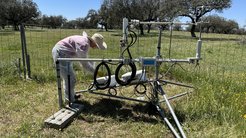
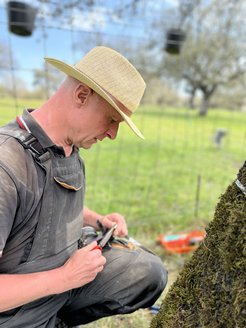
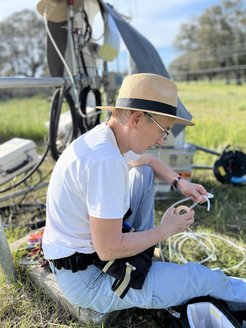
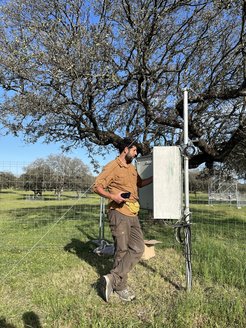

Here, the upper boom moves alternately over the tree and the meadow.





